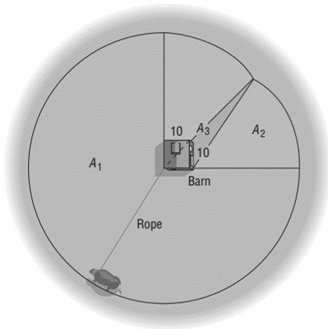
Concept explainers
To find: The maximum grazing area of the cow.
Answer to Problem 45AYU
The total area that the cow grazes is
Explanation of Solution
Given:
The given diagram is shown in Figure

Figure
The length of the rope is
Calculation:
Consider the cow grazes
Then,
Consider the barn is 10 ft by 10 ft square so at the corners the rope will remain 10 ft shorter or 90 ft only. As the cow comes from both the sides the arc of the paths overlap at point U as shown in Figure. The joining of the intersecting point to the corners of the barn forms the triangle PUR.
Consider the right angle triangle PQR by Pythagoras theorem is,
Consider the semi perimeter of the triangle is,
The area of the triangle by Heron’s formula is,
Consider the area of the gazing part inside is its difference of the area of the half barn inside the triangle that is,
To determine the angle
`
Consider by angle sum property,
Then, the area of the sector is,
Consider the triangle URS and TPS are congruent than the total area of the wedge is,
Then, the total area that the cow grazes is,
Chapter 8 Solutions
Precalculus Enhanced with Graphing Utilities
Additional Math Textbook Solutions
Elementary Statistics: Picturing the World (7th Edition)
Calculus: Early Transcendentals (2nd Edition)
Basic Business Statistics, Student Value Edition
Thinking Mathematically (6th Edition)
Elementary Statistics
College Algebra (7th Edition)
- Evaluate the following integrals, showing all your workingarrow_forwardConsider the function f(x) = 2x³-4x2-x+1. (a) Without doing a sketch, show that the cubic equation has at least one solution on the interval [0,1]. Use a theorem discussed in lectures, or see Section 1.8 of Calculus (7th ed) by Stewart. Ensure that the conditions of the theorem are satisfied (include this in your solution) (b) Now, by sketching the cubic (by hand or by computer), you should see that there is, in fact, exactly one zero in the interval [0,1]. Use Newton's method to find this zero accurate to 3 decimal places. You should include a sketch of the cubic, Newton's iteration formula, and the list of iterates. [Use a computer if possible, e.g., a spreadsheet or MatLab.]arrow_forwardEvaluate the following integrals, showing all your workingarrow_forward
- Differentiate the following functionarrow_forwardDifferentiate the following functionarrow_forwardA box with a square base and open top must have a volume of 13,500 cm³. Find the dimensions that minimise the amount of material used. Ensure you show your working to demonstrate that it is a minimum.arrow_forward
- Consider the equation, f(x) = x*. (a) Using the trapezoidal method with 3 columns, estimate the value of the integral f² f(x)dx. (b) Using the trapezoidal method with 10 columns, estimate the value of the integral f² f(x)dx. You many need software to help you do this (e.g. MATLAB, Excel, Google sheets). (c) Use software to accurately calculate the integral (e.g. Wolfram alpha, Matlab). Using this answer, comment on the answers you found in parts a) and b).arrow_forwardUsing the first-principles definition of differentiation, find the derivative of f(x) = = 2x²arrow_forwardEvaluate the following integrals, showing all your workingarrow_forward
- Differentiate the following functionarrow_forwardQuestion 1. (10 points) A researcher is studying tumours in mice. The growth rate for the volume of the tumour V(t) in cm³ is given by dV = 1.45V(2 In(V+1)). dt (a) (4 pts) Find all the equilibria and determine their stability using the stability condition. (b) (2 pts) Draw the phase plot f(V) versus V where f(V) = V'. You may find it helpful to use Desmos or Wolfram Alpha to plot the graph of f(V) versus V (both are free to use online), or you can plot it by hand if you like. On the plot identify each equilibrium as stable or unstable. (c) (4 pts) Draw direction arrows for the case where the tumour starts at size 3cm³ and for the case where the tumour starts at size 9cm³. Explain in biological terms what happens to the size of each of these tumours at time progresses.arrow_forwardFor the system consisting of the two planes:plane 1: -x + y + z = 0plane 2: 3x + y + 3z = 0a) Are the planes parallel and/or coincident? Justify your answer. What does this tell you about the solution to the system?b) Solve the system (if possible). Show a complete solution. If there is a line of intersection express it in parametric form.arrow_forward
 Calculus: Early TranscendentalsCalculusISBN:9781285741550Author:James StewartPublisher:Cengage Learning
Calculus: Early TranscendentalsCalculusISBN:9781285741550Author:James StewartPublisher:Cengage Learning Thomas' Calculus (14th Edition)CalculusISBN:9780134438986Author:Joel R. Hass, Christopher E. Heil, Maurice D. WeirPublisher:PEARSON
Thomas' Calculus (14th Edition)CalculusISBN:9780134438986Author:Joel R. Hass, Christopher E. Heil, Maurice D. WeirPublisher:PEARSON Calculus: Early Transcendentals (3rd Edition)CalculusISBN:9780134763644Author:William L. Briggs, Lyle Cochran, Bernard Gillett, Eric SchulzPublisher:PEARSON
Calculus: Early Transcendentals (3rd Edition)CalculusISBN:9780134763644Author:William L. Briggs, Lyle Cochran, Bernard Gillett, Eric SchulzPublisher:PEARSON Calculus: Early TranscendentalsCalculusISBN:9781319050740Author:Jon Rogawski, Colin Adams, Robert FranzosaPublisher:W. H. Freeman
Calculus: Early TranscendentalsCalculusISBN:9781319050740Author:Jon Rogawski, Colin Adams, Robert FranzosaPublisher:W. H. Freeman
 Calculus: Early Transcendental FunctionsCalculusISBN:9781337552516Author:Ron Larson, Bruce H. EdwardsPublisher:Cengage Learning
Calculus: Early Transcendental FunctionsCalculusISBN:9781337552516Author:Ron Larson, Bruce H. EdwardsPublisher:Cengage Learning





